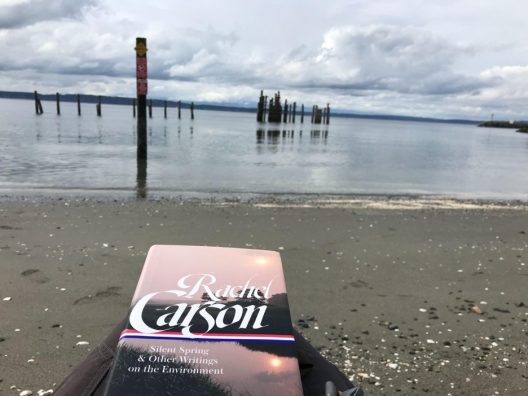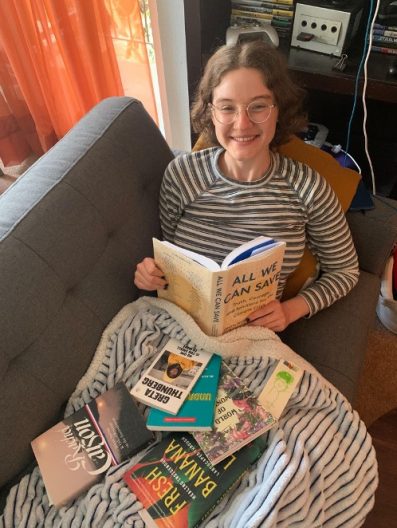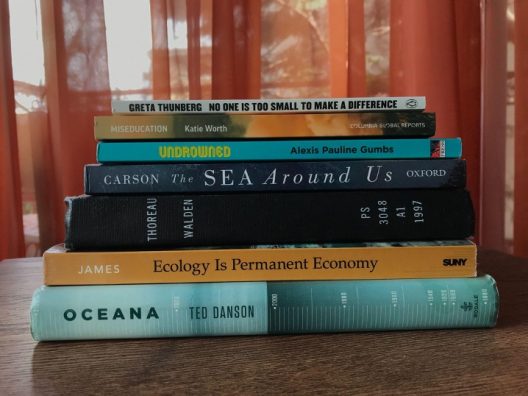Reflections and Recommendations: What is Kat Reading?
Since I started pursuing my bachelor’s degree in marine biology, my dad has gifted me books for what he calls my “professional library.” As my shelves filled, so did my schedule, until there was little time to read for pleasure. Reading has always been a passion of mine, and I have always been dismayed when there is little opportunity to immerse myself in whatever book is calling my name. When I lent my dad Rachel Carson’s “The Sea Around Us,“ a book that had been gathering dust on my desk, I was happily surprised to find him enamored by her writing, quoting facts and anecdotes to me about one of my truest loves: the ocean.
Inspired by my father’s excitement and my desire to slow down my own life, I dedicated my spring break to reading and curating my own collection of inspirational environmental writings.

Silent Spring, By Rachel Carson
The spring of 2022 has been anything but silent. As I sit on the beach soaking in the sun and listening to the gulls, or watch the berry bush at my window dip and shake with the weight of robins, I am overwhelmed with gratitude for the fact that “Silent Spring” captured the world’s attention when it was published in 1962. Carson paints the insidious and suffocating nature of chemical poisoning on unsuspecting farm workers, birds, soils, and drinking water, in ways that feel familiar and yet alien; it seems so obvious to me that liberally spraying poisons developed for World War II would be harmful. I grew up in a culture shaped by decades of environmental activism and education, and as such have had both the privilege and burden of knowing about climate change and environmental degradation from a young age.
Reading about parents and farm workers who had no knowledge about the dangers of DDT or arsenic-based herbicides until it was too late incited in me its own kind of retroactive grief, one for what has been lost and maimed while the United States government said that everything was okay. Carson writes, “Much of the necessary knowledge is now available but we do not use it. We train ecologists in our universities and even employ them in our governmental agencies but we seldom take their advice.” I feel a kinship with those whose eyes were opened in 1962; by the time “Silent Spring” was published, the damaging effects of dangerous insecticides had already occurred, and their use was still ramping up. For me, growing up with the weight of knowledge about climate change and environmental degradation often feels like an insurmountable challenge. But the impact of “Silent Spring” is an important success story of societal education and mobilization, and it helps me keep my eyes on the prize of environmental conservation.
It feels disrespectful to critique the writers that helped build the foundation for our current environmental movement; they walked so we could run. But I wish there could have been greater acceptance for more diverse perspectives to shape the environmental movement, just as Carson’s writing did. If the mainstream environmental movement wasn’t dominated by white conservationism from the get-go, who knows what our future could have looked like. Because of this, I was excited to jump into the next books on my list…
Fresh Banana Leaves: Healing Indigenous Landscapes Through Indigenous Science, By Jessica Hernandez
Dr. Hernandez starts her poignant and educational book the same way I started my article: writing about her father. Published just two months ago, Hernandez weaves interviews, case studies, and insights of Indigenous science together to introduce us to the past, present, and possible future of post-colonial environmentalism in Latin America, specifically El Salvador and Mexico, and in the Pacific Northwest of the United States. Hernandez self-identifies as a transnational (Maya Ch’orti’ and Zapotec) Indigenous scholar, scientist, and advocate. She uses accessible and engaging language to convey more technical topics that I have learned about in purely academic settings, avoiding jargon that is oftentimes unfamiliar to the general public. For example, while Carson describes the long-lasting affects of bioaccumulation of chemicals in soil and fatty tissues of animals as a result of DDT spraying, Hernandez describes similar phenomenons in a human-centered manner: “our environment can carry our trauma – trauma that can be traced to settler colonialism, when our ancestors were murdered, displaces, and forced to live under the Western European concepts of culture, science, and capitalism that still govern our current societies – as well as our healing.” Reading these two books back to back was a great mental exercise to compare and contrast the authors’ lenses while reading.
““Our environment can carry our trauma – trauma that can be traced to settler colonialism, when our ancestors were murdered, displaces, and forced to live under the Western European concepts of culture, science, and capitalism that still govern our current societies – as well as our healing.” – Dr. Jessica Hernandez”
As a student who uses phrases such as “environmental justice,” “conservation,” and “community collaboration” more times than I could ever count, “Fresh Banana Leaves” has kindly reminded me that knowing the historical context and weight of these phrases is of paramount importance. Hernandez writes: “…environmental justice has been a term that has been co-opted by many because sometimes their use of the term does not lead to any action, implementation, or community-based work that centers the community seeking environmental justice…we must not forget that behind environmental justice, there are communities’ livelihoods and well-being at stake. Communities of color do not choose to do this work but rather have to do this work as a means of survival for them and their future generations.” Many white scientists I have studied and worked with are surprised by the seemingly recent vocalization to center women, Indigenous, and people of color’s voices in the scientific realm. I would recommend “Fresh Banana Leaves” to these people, because it is a beautifully written and informative introduction to Indigenous environmental perspectives. I learned a lot from “Fresh Banana Leaves” because it connects the scientific field, which I am familiar with, with human dimensions of Indingeous people, such as race, gender, religion and traditions, which is a totally new and exciting field for me.

All We Can Save: Truth, Courage, and Solutions for the Climate Crisis, Edited by Ayana Elizabeth Johnson and Katharine Wilkinson
I have been slowly reading “All We Can Save” since it was published, and I am proudly a close follower of Dr. Johnson, Dr. Wilkinson, and their network of climate champions. “All We Can Save” is organized into eight themes: “Root,” “Advocate,” “Reframe,” “Reshape,” “Persist,” “Feel,” “Nourish,” and “Rise.” Each section contains essays by pioneering women in the climate movement. I feel empowered when I recognize one of the many contributing authors of this anthology; it is a reminder of the hard work I have put in to educate myself and become familiar with the current leaders in the fight against climate change.
I do not read “All We Can Save” straight through, as I would a novel, because I do not always have the mental tolerance for poignant descriptions of the impacts of environmental degradation and climate change. Instead, I pick up this anthology every so often and savor the author’s writings. Each author’s contribution provides a different kind of medicine, so as I read I take a moment to reflect on what I might need from the author. Do I need motivation in my academic pursuit of policy? Then I might read Leah Cardamore Stokes’ “A Field Guide for Transformation.” Do I seek inspiration from the youth who are picking up the mantle of activism? Then I’ll flip to Alexandria Villaseñor’s “A Letter to Adults.” When I need to feel seen and acknowledge my ecoanxiety, I will read “Under the Weather” by Ash Sanders.
I love this book because of the solidarity and togetherness I feel while reading; it is important to remember that we aren’t alone in the fight against climate change.
“I love this book because of the solidarity and togetherness I feel while reading; it is important to remember that we aren’t alone in the fight against climate change.”
World of Wonders, By Aimee Nezhukumatathil
Learning about and working in the climate change and environmental field has been a heavy mental burden to hold constantly. It is difficult to compartmentalize the potentially dismal future of our earth while pursuing an intensive two year degree that requires hours of learning and reflecting on that very topic. That’s where “World of Wonders” comes in to save the day. Nezhukumatathil writes, “Where does one start to take care of these living things amid the dire and daily news of climate change, and reports of another animal or plant vanishing from the planet? How can one even imagine us getting back to a place where we know the names of the trees we walk by every single day? A place where ‘a bird’ navigating a dewy meadow is transformed into something more specific, something we can hold onto by feeling its name on our tongues: brown thrasher. Or ‘that big tree’: catalpa. Maybe what we can do when we feel overwhelmed is to start small. Start with what we have loved as kids and see where that leads us.”
My sister bought me Nezhukumatathil’s collection of short, poetic essays on the recommendation that this book “is a spa for your brain.” I couldn’t agree more. Each essay is focused on Nezhukumatathil’s relationship with a species, ranging from fruits to birds to insects. Of all the books I read over spring break, I felt the most peaceful and relaxed while reading “World of Wonders” and reveling in the miracle that is Earth. As a biologist, I was picking up interesting facts about each species along the way, but anyone with an interest in nature, parenthood, or creative writing will connect with Nezhukumatathil’s work. I see incredible value for those of us working in the environmental fields to take time out of our day to purely enjoy, without analyzing or critiquing, what it is we are working so hard to restore and preserve. Do yourself a favor, and pick up “World of Wonders.”
Final Thoughts
I have a whole stack of books that I wanted to include in this project but didn’t have time for, but I am glad that I made the time to sit in some beautiful nature and read “Silent Spring,” “Fresh Banana Leaves,” “All We Can Save,” and “World of Wonders” during my spring break. The opportunity to learn from different people’s perspectives is so valuable, and I love connecting with people over the books they enjoy. This project has helped me remember how mentally nourishing reading can be, and I want to prioritize reading for pleasure, especially during hectic periods of my life.

“I feel honored to be entering this field of work standing on the shoulders of these giants; while the task ahead of us is daunting, there is no lack of passion, intelligence, or creativity from the people working tirelessly to change the world.”
While I never intended to select exclusively female authors for this project, this coincidence appropriately mirrors the people that are most affected by and invested in leading our world on the climate crisis. It is a powerful feeling to know that so many people, so many women, are using their lived experiences and diverse educations to lead the environmental movement. I feel honored to be entering this field of work standing on the shoulders of these giants; while the task ahead of us is daunting, there is no lack of passion, intelligence, or creativity from the people working tirelessly to change the world.